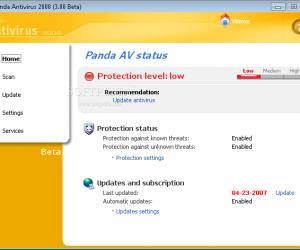

- #KINGSOFT ANTIVIRUS SERIAL NUMBER KEY CODES INSTALL#
- #KINGSOFT ANTIVIRUS SERIAL NUMBER KEY CODES CODE#
- #KINGSOFT ANTIVIRUS SERIAL NUMBER KEY CODES DOWNLOAD#
- #KINGSOFT ANTIVIRUS SERIAL NUMBER KEY CODES WINDOWS#
This is important because Lurk will only run in the context of Internet Explorer (iexplore.exe) or Firefox (firefox.exe). The malware establishes persistence by creating the registry key: HKEY_CURRENT_USER\ SOFTWARE\Classes\CLSID\\InProcServer32, with the default value set to the path of the Lurk DLL in the temporary directory and the ThreadingModel value set to "both." The registry keys ensure that Lurk's DLL will be loaded into the process space of the COM client executable specified by the CLSID "A3CCEDF7-2DE2-11D0-86F4-00A0C913F750," which corresponds to Internet Explorer's PNG plugin image decoder. It uses a filename assigned by GetTempFileNameA appended with a ".tmp" extension.
#KINGSOFT ANTIVIRUS SERIAL NUMBER KEY CODES WINDOWS#
Lurk installs itself on the infected system by copying itself to a temporary directory via the GetTempPathA Windows API function. If the check does not reveal any of the 21 products, Lurk adds the detected products to an integer array list that is sent to the command and control (C2) server.
#KINGSOFT ANTIVIRUS SERIAL NUMBER KEY CODES INSTALL#
If Lurk detects any of the 21 products indicated in bold italics, it does not install itself on the infected system. (Source: Dell SecureWorks)Īfter the main Lurk payload DLL executes, it checks the infected system for the installation of 52 different security products (see Table 1) by searching the registry for keys under HKEY_LOCAL_MACHINE\Software and HKEY_CURRENT_USER\Software.
#KINGSOFT ANTIVIRUS SERIAL NUMBER KEY CODES CODE#
Primary Lurk DLL malware code embedded in two bitmap images. The seemingly random noise in the right-half of the images is the actual malware code that is extracted by calling several Windows graphics API functions.įigure 2. Figure 2 shows two bitmap images from the resource section of Lurk samples. Some Lurk variants load a bitmap image from the resource section of the dropper DLL. After deriving the key, the malware payload is decoded by performing another XOR operation on each byte of data from offset N with each byte of the XOR key.įigure 1. The key is obtained by performing an XOR operation on a hard-coded value of length N with the first N bytes of the embedded data. The extraction code begins by deriving an XOR key that is used to decrypt the payload DLL. In some Lurk samples, the malware payload is embedded as data in the resource section. Lurk's real dropper code is contained in the DLLMain function. As shown in Figure 1, the Lurk dropper DLL contains several exports that appear to be legitimate, but in fact lead to garbage code designed to mislead antivirus products and security researchers. The dropper DLL’s main purpose is to extract and load the payload DLL. Lurk consists of two components: a dropper DLL and a payload DLL. This lack of information may be due to Lurk's unconventional implementation and use of digital steganography.

When CTU researchers began investigating Lurk, they found very little published information about the malware's behavior, operation, and function. If a person visiting one of these websites was running a vulnerable version of Adobe Flash, the exploit dropped a DLL file and executed the Lurk malware. At the time, Lurk was being propagated through an HTML iFrame on compromised websites that loaded a Flash-based exploit for CVE-2013-5330. As a result, Lurk may be able to evade network defenses and hide in plain sight.ĭistribution of the Lurk malware was first described in February 2014 by a security researcher known as Kafeine. In contrast, it is unlikely that existing IPS/IDS devices could detect data that is concealed with digital steganography. These modifications are relatively easy to detect by a commercially available intrusion prevention system (IPS) or intrusion detection system (IDS). The most commonly used method simply appends data (such as a configuration file or a command) to the end of an image file. Some malware families, notably the KINS banking trojan (which is based on leaked Zeus source code and is also known as ZeusVM), have incorporated non-digital steganographic techniques. In particular, the Dell SecureWorks Counter Threat Unit™ (CTU) research team has observed Lurk dropping malware used to commit click fraud.
#KINGSOFT ANTIVIRUS SERIAL NUMBER KEY CODES DOWNLOAD#
Lurk's primary purpose is to download and execute secondary malware payloads. The resulting image contains additional data that is virtually invisible to an observer.

Lurk specifically uses an algorithm that can embed encrypted URLs into an image file by inconspicuously manipulating individual pixels. Lurk is a malware downloader that uses digital steganography: the art of hiding secret information within a digital format, such as an image, audio, or video file.


 0 kommentar(er)
0 kommentar(er)
